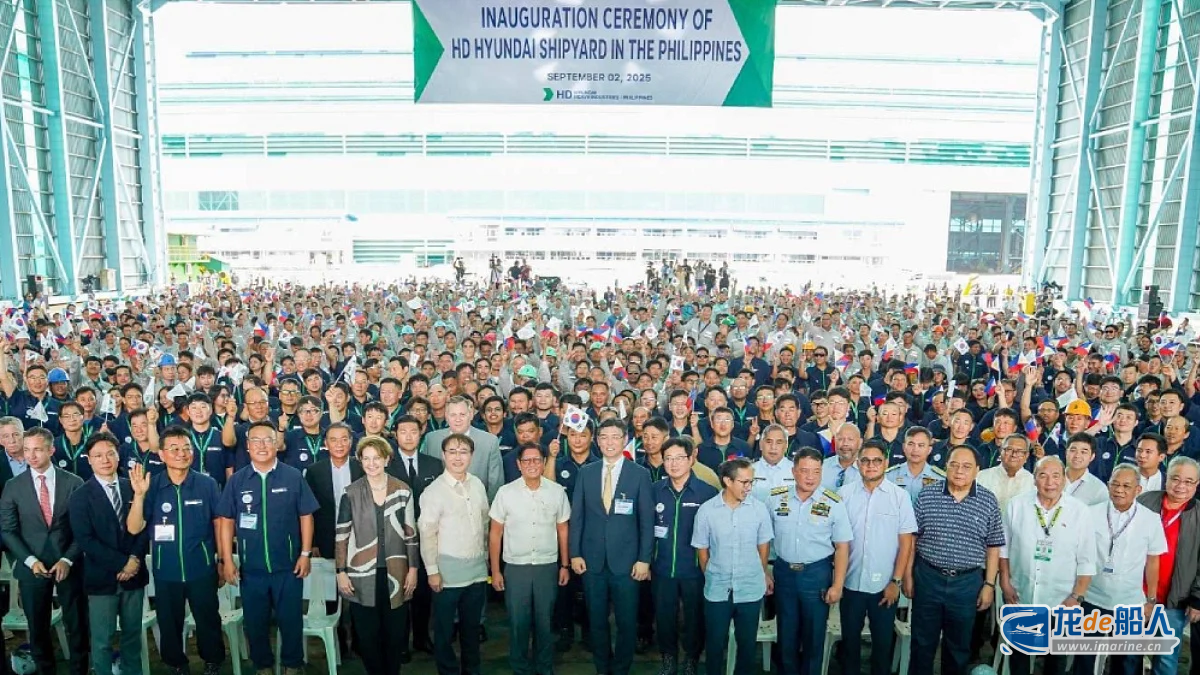On September 2, HD Hyundai Heavy Industries, a subsidiary of HD Korea Shipbuilding & Offshore Engineering (HD KSOE), held a steel-cutting ceremony for a 115,000 DWT LR2 product tanker at its Subic Shipyard through the newly established HD Hyundai Philippines. This marked the official launch of HD Hyundai’s shipbuilding operations in the Philippines and the resumption of shipbuilding at the Subic Shipyard after a long hiatus.

Philippine President Ferdinand Marcos Jr., U.S. Ambassador to the Philippines Mary Kay Carlson, and South Korean Ambassador to the Philippines Lee Sang-hwa attended the ceremony.
At the ceremony, Philippine President Ferdinand Marcos Jr. announced plans to revitalize the nation’s shipbuilding industry, pledging to “reclaim our rightful place among the world’s leading shipbuilding powers.” He stated: “From 2014 to 2018, the Philippines achieved an average annual shipbuilding capacity of 2 million gross tons. However, this momentum stalled after 2019. Today, we are setting sail once again.”
According to HD Hyundai Heavy Industries’ plan, the Subic shipyard will initially focus on building product tankers with a maximum length of 250 meters, with each vessel’s construction cycle expected to take 16 to 18 months.
The construction of the first of four 115,000 DWT LR2 product tankers ordered by Asian shipowner Cido Shipping from HD Hyundai Heavy Industries is underway. Nissin Shipping’s two and two 115,000 DWT LR2 product tankers will also be built at Subic Shipyard.
Public information indicates that the Subic Shipyard, established in 2006 by HJ Shipbuilding & Construction (formerly HANJIN Heavy Industries & Construction), was once ranked among the top five shipyards globally and the largest shipyard in Southeast Asia. Located on the north side of Subic Bay, the yard primarily builds large container ships, gas carriers and oil tankers. Its first newbuilding was delivered in 2008. At its peak, the yard employed over 20,000 people. It had previously delivered 20,000 TEU container ships and several Very Large Cell Carriers (VLCCs).
In April 2022, U.S. private equity giant Cerberus acquired the Subic Shipyard—which had been bankrupt for three years—for $300 million with a 50-year lease. It subsequently invested $40 million to revitalize the business. In August 2025, Cerberus announced it would inject $250 million over the next 12 months to strengthen its business footprint in the Philippines, including an upgrade and renovation project for the Subic Shipyard.
In May 2024, HD KSOE signed an agreement with Cerberus to lease part of the Subic Shipyard, announcing plans to invest approximately $550 million over the next 10 years, bringing its annual production capacity to a maximum of 10 vessels. Starting in 2026, the Subic Shipyard’s annual production capacity is expected to increase from 1.3 million deadweight tons to 2.5 million deadweight tons, and will also support the construction of offshore wind power projects.
It is worth noting that the Philippines is no stranger to the global shipbuilding industry. Between 2010 and 2018, the country ranked fourth globally in shipbuilding output, trailing only South Korea, China, and Japan. Shipyards such as Tsuneishi Heavy Industries in Subic and Cebu lead the Philippine shipbuilding industry.
In related news, HD Hyundai plans to deepen economic security cooperation among South Korea, the United States, and the Philippines through HD Hyundai Philippines.
As early as 2022, HD Hyundai Heavy Industries established a logistics support center in the Philippines to provide maintenance, repair, and overhaul (MRO) services for Philippine Navy frigates, patrol vessels, and other naval vessels.
Based on this experience and accumulated technology, HD Hyundai plans to establish a cooperation framework with the Philippine government, positioning HD Hyundai Philippines as another strategic hub for the Korea-US shipbuilding cooperation project, “Make American Shipbuilding Great Again” (MASGA), and hopes to maximize efficiency through coordinated operations with overseas core bases.
HD Hyundai Philippines is strategically located adjacent to HD Hyundai Vietnam Shipbuilding, HD Hyundai Vina (tentative name) and a Singapore investment entity (under planning). This strategic layout enables the sharing of hull section and liquid cargo tank supply chains, as well as the synergistic operation of labor resources.
An HD KSOE representative stated, “Thanks to strong government support, abundant natural resources, and highly qualified human resources, the Philippines is emerging as a new shipbuilding powerhouse. Leveraging HD Hyundai Philippines, we will further enhance our global competitiveness and secure new orders.”


